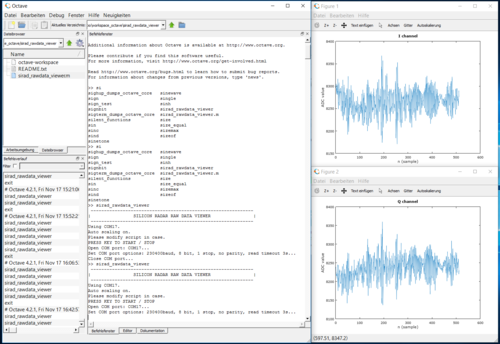Difference between revisions of "MATLAB & Octave"
| Line 7: | Line 7: | ||
* Octave instrument-control package v0.3.0 or newer [https://octave.sourceforge.io/packages.php][https://octave.org/doc/v4.2.1/Installing-and-Removing-Packages.html] | * Octave instrument-control package v0.3.0 or newer [https://octave.sourceforge.io/packages.php][https://octave.org/doc/v4.2.1/Installing-and-Removing-Packages.html] | ||
| − | We provide free scripts for connecting to Octave via UART | + | We provide free scripts for connecting to Octave via UART to collect the ADC raw data, please see below. The scripts support the acquisition and visualization of the ADC raw data (digitized IF outputs of our radar front ends) as well as the configuration of the evaluation kit via our configuration protocol to set it up for the ADC raw data mode. |
== Download == | == Download == | ||
| Line 16: | Line 16: | ||
You will be required to open a UART communication specifying the COM port of the radar in MATLAB and baudrate (230400 baud) via the Octave instrument-control package. You can then transmit the configuration frames using the standard protocol as indicated in the protocol documentation (page 15 Sec. 3.2 “Send command”):. You will also receive the data from the radar through the serial communication interface once it is correctly opened. Please see the official MATLAB documentation regarding the managing of a serial interface [https://de.mathworks.com/help/matlab/ref/serial.html]. | You will be required to open a UART communication specifying the COM port of the radar in MATLAB and baudrate (230400 baud) via the Octave instrument-control package. You can then transmit the configuration frames using the standard protocol as indicated in the protocol documentation (page 15 Sec. 3.2 “Send command”):. You will also receive the data from the radar through the serial communication interface once it is correctly opened. Please see the official MATLAB documentation regarding the managing of a serial interface [https://de.mathworks.com/help/matlab/ref/serial.html]. | ||
| − | |||
| − | |||
| − | |||
| − | |||
| − | |||
| − | |||
| − | |||
| − | |||
Revision as of 21:01, 18 February 2019
Octave
Our products SiRad Easy and SiRad Simple can be used with the free MATLAB alternative Octave - a software for scientific calculations and visualization - available from [1]. Octave run on GNU/Linux, macOS, BSD, and Windows and is mostly MATLAB compatible.
System requirements:
We provide free scripts for connecting to Octave via UART to collect the ADC raw data, please see below. The scripts support the acquisition and visualization of the ADC raw data (digitized IF outputs of our radar front ends) as well as the configuration of the evaluation kit via our configuration protocol to set it up for the ADC raw data mode.
Download
You can download the Octave connector script in our Customer Download Area (you have to register at our site).
How to
You will be required to open a UART communication specifying the COM port of the radar in MATLAB and baudrate (230400 baud) via the Octave instrument-control package. You can then transmit the configuration frames using the standard protocol as indicated in the protocol documentation (page 15 Sec. 3.2 “Send command”):. You will also receive the data from the radar through the serial communication interface once it is correctly opened. Please see the official MATLAB documentation regarding the managing of a serial interface [4].
